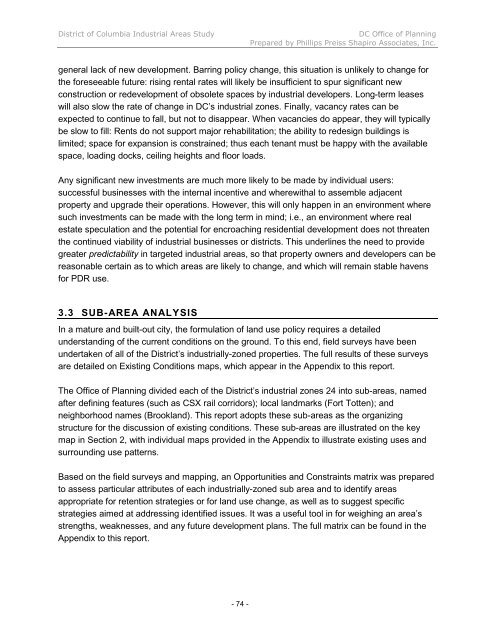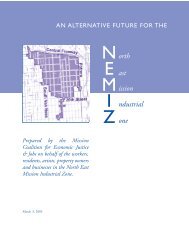INDUSTRIAL LAND IN A POST-INDUSTRIAL CITY District of ...
INDUSTRIAL LAND IN A POST-INDUSTRIAL CITY District of ...
INDUSTRIAL LAND IN A POST-INDUSTRIAL CITY District of ...
You also want an ePaper? Increase the reach of your titles
YUMPU automatically turns print PDFs into web optimized ePapers that Google loves.
<strong>District</strong> <strong>of</strong> Columbia Industrial Areas Study DC Office <strong>of</strong> Planning<br />
Prepared by Phillips Preiss Shapiro Associates, Inc.<br />
general lack <strong>of</strong> new development. Barring policy change, this situation is unlikely to change for<br />
the foreseeable future: rising rental rates will likely be insufficient to spur significant new<br />
construction or redevelopment <strong>of</strong> obsolete spaces by industrial developers. Long-term leases<br />
will also slow the rate <strong>of</strong> change in DC’s industrial zones. Finally, vacancy rates can be<br />
expected to continue to fall, but not to disappear. When vacancies do appear, they will typically<br />
be slow to fill: Rents do not support major rehabilitation; the ability to redesign buildings is<br />
limited; space for expansion is constrained; thus each tenant must be happy with the available<br />
space, loading docks, ceiling heights and floor loads.<br />
Any significant new investments are much more likely to be made by individual users:<br />
successful businesses with the internal incentive and wherewithal to assemble adjacent<br />
property and upgrade their operations. However, this will only happen in an environment where<br />
such investments can be made with the long term in mind; i.e., an environment where real<br />
estate speculation and the potential for encroaching residential development does not threaten<br />
the continued viability <strong>of</strong> industrial businesses or districts. This underlines the need to provide<br />
greater predictability in targeted industrial areas, so that property owners and developers can be<br />
reasonable certain as to which areas are likely to change, and which will remain stable havens<br />
for PDR use.<br />
3.3 SUB-AREA ANALYSIS<br />
In a mature and built-out city, the formulation <strong>of</strong> land use policy requires a detailed<br />
understanding <strong>of</strong> the current conditions on the ground. To this end, field surveys have been<br />
undertaken <strong>of</strong> all <strong>of</strong> the <strong>District</strong>’s industrially-zoned properties. The full results <strong>of</strong> these surveys<br />
are detailed on Existing Conditions maps, which appear in the Appendix to this report.<br />
The Office <strong>of</strong> Planning divided each <strong>of</strong> the <strong>District</strong>’s industrial zones 24 into sub-areas, named<br />
after defining features (such as CSX rail corridors); local landmarks (Fort Totten); and<br />
neighborhood names (Brookland). This report adopts these sub-areas as the organizing<br />
structure for the discussion <strong>of</strong> existing conditions. These sub-areas are illustrated on the key<br />
map in Section 2, with individual maps provided in the Appendix to illustrate existing uses and<br />
surrounding use patterns.<br />
Based on the field surveys and mapping, an Opportunities and Constraints matrix was prepared<br />
to assess particular attributes <strong>of</strong> each industrially-zoned sub area and to identify areas<br />
appropriate for retention strategies or for land use change, as well as to suggest specific<br />
strategies aimed at addressing identified issues. It was a useful tool in for weighing an area’s<br />
strengths, weaknesses, and any future development plans. The full matrix can be found in the<br />
Appendix to this report.<br />
- 74 -












